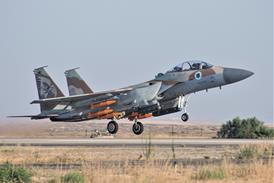Air force officials move to uphold commitments to boost F/A-22 production as threat of budget cuts looms
The first crash of a production Lockheed Martin/Boeing F/A-22 Raptor late last month is unlikely to pose an immediate threat to the US Air Force's top acquisition priority, but the incident will bring fresh scrutiny of an embattled programme as it enters a tenuous budgeting cycle.
USAF officials quickly moved to restate its commitment in 2005 to boost F/A-22 production from 24 to 32 aircraft a year, as well as stand up the first operational Raptor unit by next December.
"We're going to keep right on going," says Maj Gen Stephen Goldfein, commander of the Air Warfare Centre at Nellis AFB in Nevada, the site of the 20 December non-fatal crash of an F/A-22, which happened shortly after take-off.
However, the Raptor fleet remains grounded under a "safety stand-down" triggered by the crash.
Several US aircraft development programmes have overcome worse disasters. In 2000, the Bell Boeing MV-22 Osprey tiltrotor programme suffered two crashes within eight months that killed more than 20 people, but the programme survives today after a costly rehabilitation effort.
But the loss of the F/A-22 last month arrives as US military weapons programmes come under increasing budgetary pressure caused by the cost of supporting growing operational commitments.
Defence industry watchers are expecting the Bush administration to unveil a 2006 spending proposal next month that includes steep cuts in both the F/A-22 and Lockheed Martin F-35 Joint Strike Fighter programmes.
Little is known about the sequence of events that happened in the accident. The pilot made the decision to eject moments after the aircraft lifted off the runway and two main areas of wreckage were located at the far north end of the Nellis runway. The charred remains of the aircraft's mid- and rear fuselage, including the Raptor's distinctive V-tail, were contained in one location.
STEPHEN TRIMBLE / WASHINGTON DC
Source: Flight International























